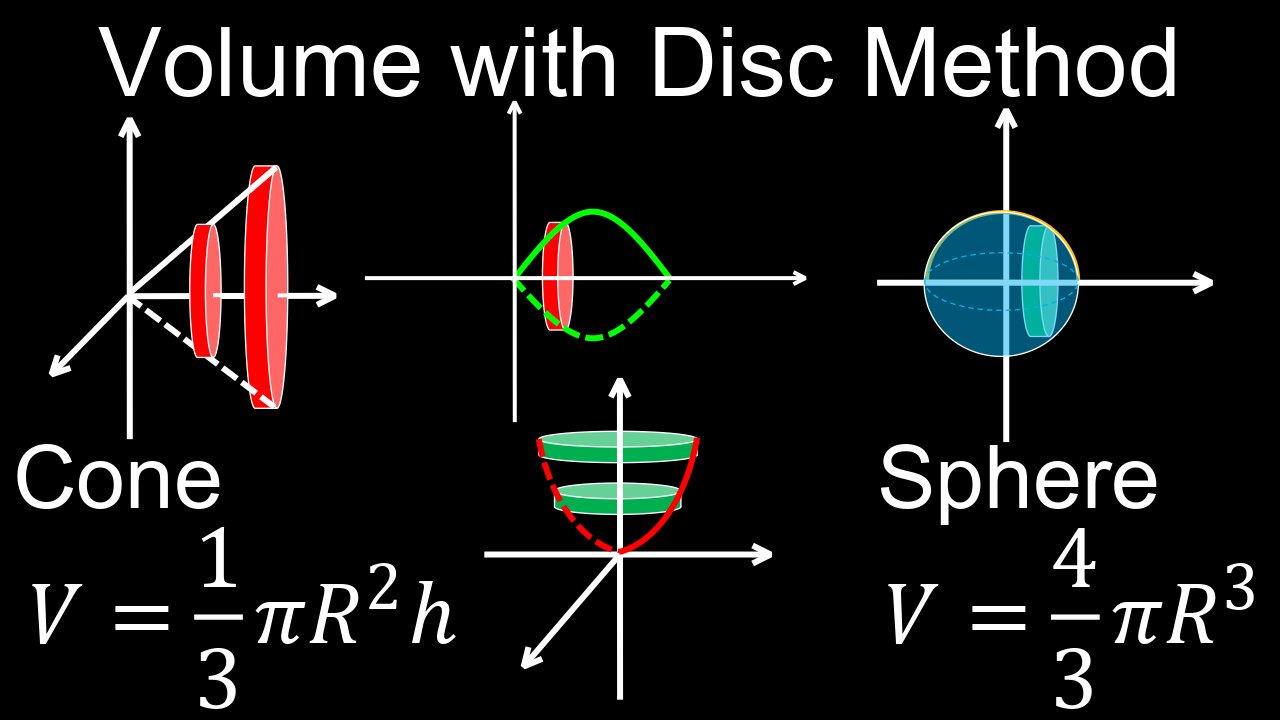Premium Only Content

Volume with the Disc Method, Solids of Revolution, Examples, Practice Problems - Calculus
The disk method calculates the volume of a solid of revolution by integrating the areas of infinitesimally thin circular disks, which are stacked to form the solid. The volume of a single disk is its cross-sectional area, \(\pi r^{2}\), multiplied by its thickness (either \(dx\) or \(dy\)). The total volume is found by integrating this expression over the limits of the solid's extent along the axis of rotation, yielding the formula \(V=\int _{a}^{b}\pi [r(x)]^{2}dx\) when rotating around the x-axis.
💡How the Disk Method Works
• Visualize the Solid: Imagine a 2D region being rotated around an axis to create a 3D solid.
Identify the Cross-Section: The cross-section of the solid, perpendicular to the axis of rotation, will be a circle (a disk).
• Determine the Radius: The radius (\(r\)) of this disk is the distance from the axis of rotation to the outer boundary of the region being rotated.
• Calculate the Area: The area of this circular disk is given by \(A=\pi r^{2}\).
• Introduce Thickness: The thickness of the disk is an infinitesimal value, represented as \(dx\) if you are integrating along the x-axis or \(dy\) if you are integrating along the y-axis.
• Formulate the Integral: The volume of the entire solid is found by summing (integrating) the volumes of an infinite number of these disks across the region's extent.
💡Formulas
• Rotating around the x-axis: If a region is bounded by a function \(f(x)\) and the x-axis from \(x=a\) to \(x=b\), and rotated around the x-axis, the volume is:
\(V=\int _{a}^{b}\pi [f(x)]^{2}dx\)
• Here, \(r(x)=f(x)\) is the radius, and the thickness is \(dx\).
• Rotating around the y-axis: If a region is bounded by a function \(g(y)\) and the y-axis from \(y=c\) to \(y=d\), and rotated around the y-axis, the volume is:
\(V=\int _{c}^{d}\pi [g(y)]^{2}dy\)
• Here, \(r(y)=g(y)\) is the radius, and the thickness is \(dy\).
💡Key Considerations
• Axis of Rotation: The formula and the choice of \(dx\) or \(dy\) depend on whether the rotation is around the x-axis or the y-axis.
• Radius Function: The radius must be expressed as a function of the variable of integration (x or y).
• Integral Limits: The integral is evaluated between the specified limits of the region being rotated.
💡Worksheets are provided in PDF format to further improve your understanding:
• Questions Worksheet: https://drive.google.com/file/d/1GQtYzPXeZpvnm7EdpOAPfEyr-VSltAse/view?usp=drive_link
• Answers: https://drive.google.com/file/d/1urkbDfPaDPsymE8T58TZZJHgeUw-P-qx/view?usp=drive_link
💡Chapters:
00:00 Volume with the disc method, revolve about x and y axes, with examples
04:11 Disc method, revolve about other axes, with example
🔔Don’t forget to Like, Share & Subscribe for more easy-to-follow Calculus tutorials.
🔔Subscribe: https://rumble.com/user/drofeng
_______________________
⏩Playlist Link: https://rumble.com/playlists/Ptm8YeEDb_g
_______________________
💥 Follow us on Social Media 💥
🎵TikTok: https://www.tiktok.com/@drofeng?lang=en
𝕏: https://x.com/DrOfEng
🥊: https://youtube.com/@drofeng
-
 20:39
20:39
Professor Nez
1 hour agoNEW Epstein Leak Just Changed EVERYTHING!
6.6K6 -
 LIVE
LIVE
SilverFox
13 hours ago🔴LIVE - ARC Raiders - SilverFox x Grimm Hollywood - BETRAYAL DAY
121 watching -
 LIVE
LIVE
The Charlie Kirk Show
1 hour agoTrans Thomas Crooks? + Who Wants To Leave + Is Inflation Over?| Hassett, Emmons, Sec. Turner | 11.17
3,678 watching -
 56:51
56:51
The Rubin Report
3 hours agoOnline Outrage After Michelle Obama Tries to Play the Victim Card
77.7K56 -
 LIVE
LIVE
LFA TV
20 hours agoLIVE & BREAKING NEWS! | MONDAY 11/17/25
2,504 watching -
 1:44:36
1:44:36
The Mel K Show
2 hours agoMORNINGS WITH MEL K - Stop Participating in Chaos-They Need You Distracted - 11-17-25
17.7K2 -
 LIVE
LIVE
The Shannon Joy Show
2 hours agoTrump Flip Flops On Epstein Files - Demands Release * MAGA & MAHA Pysops Crash & Burn While ‘America First’ Psyop Launches
224 watching -
 1:01:26
1:01:26
Grant Stinchfield
19 hours ago $1.90 earnedEXPLOSSIVE NEW EMAILS REVEAL: DEMS TOOK ‘GET TRUMP’ ADVICE DIRECTLY FROM EPSTEIN!”
13.4K4 -
 1:01:49
1:01:49
VINCE
5 hours agoThe Democrats Were In On It? | Episode 170 - 11/17/25 VINCE
253K121 -
 1:57:29
1:57:29
Benny Johnson
4 hours ago🚨Trump Assassin Thomas Crooks Was Groomed by Trans 'Furry' Ideology | Trump: ‘Release Epstein Files!’
74.5K72